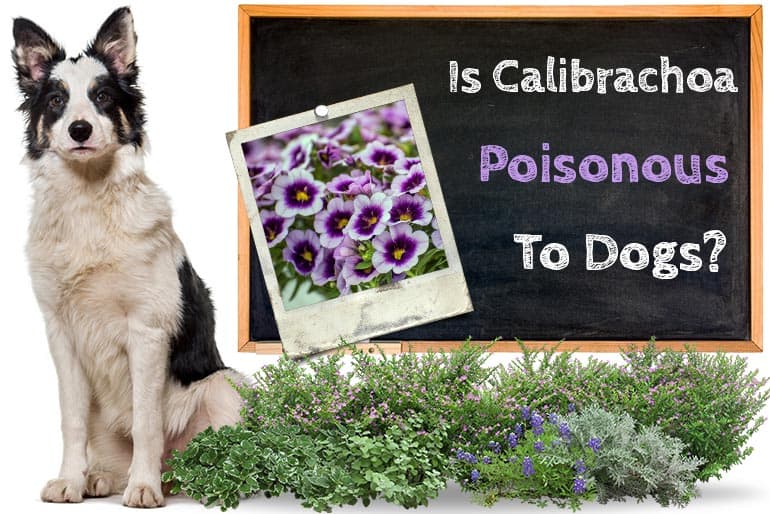Hearing the term Calibrachoa might send people running because of how the name sounds villainous and diabolical to you and your dog.
The truth is, Calibrachoa is simply a genus referring to evergreen shrubs growing beautiful petunia-looking flowers. That is it.
But just because we have established what Calibrachoa is, it means that we can already self-proclaim that it is okay for dogs.
It is still a pressing question to ask that many still doubt the answer to.
But really, “is it harmful to have around my pet dog?” Stay tuned and keep reading, and we shall uncover the answer in the following narratives.
Before realizing the effects of having Calibrachoa lying around your pet dog’s vicinity, we must first understand what the Calibrachoa plant is and some related features about it.
What is Calibrachoa?

Calibrachoa, or more scientifically referred to as Calibrachoa parviflora, is a class of short-lived perennial shrubs grown primarily for their minimalist, aesthetic beauties.
Also called “a million bells,” these plants are relatively new to the botanical world but have certainly made the mark of being a must-have in gardens these days.
They come in a plethora of colors resembling that of the inflorescence of petunia plants.
What makes these plants great for gardens is their spiller-type aesthetic.
Placing them in hanging baskets or pots will give the beautiful illusion of these plants spilling from the brim.
Any vacant space in your garden will appreciate being graced by the beauty of such magnificent plants.
Due to the newness of such crops in the public’s eyes, there has been difficult having a consensus whether they are a variety of petunias or a class of their own.
The Royal Horticultural Society believed them to be petunias, giving them the cultivar name of Petunia “million bells.”
Although they boast aesthetic qualities, are they safe to have around, especially for curious animals such as dogs?
Will their safety be ensured despite being near Calibrachoa plants?
Learn More:
Is Calibrachoa safe for dogs?
Although the Spruce classifies the beautiful Calibrachoa as non-toxic, it helps us become cautious and meticulous at the types of plants we let in our abode.
We must keep in mind that Calibrachoa plants belong to the Solanaceae or nightshade family, which has not been the friendliest to cats and dogs.
As the name itself means, plants belonging to this family contain an alkaloid called solanine, which may be problematic when ingested by dogs, especially in large quantities.
Solanine is an alkaloid with pesticide characteristics initially formed to serve as defense mechanisms of plants against pests.
The problem with this is that it is considered a cholinesterase inhibitor that prevents acetylcholine from the brain.
The buildup of such may cause neurological problems in the long run.
The following are signs of nightshade poisoning:
- Tremors
- Weakness of the muscles
- Gastrointestinal problems
- Diarrhea
- Excessive drooling
- Seizures
- Loss of bodily coordination
- Cardiac effects
Solanine can not only be found in fruits, but every organ of a plant containing such alkaloid can contain the chemical that may cause adverse effects not only to dogs but also to humans.
Although there are no concrete pieces of evidence that suggest that Calibrachoa contains such alkaloids, it helps to be cautious.
They belong to the same family of nightshades. Therefore, the probability of these plants having solanine in their system is likely.
Moreover, solanine is not necessarily poisonous when consumed.
But the consumption of large quantities is the one that causes toxicity and what you have to look out for.
How to avoid potential dog toxicity while having Calibrachoa?

Anybody will want a win-win situation.
People would want to be in a situation where they get to keep their dog safe from potential nightshade poisoning while still having an extra aesthetic feature in your garden offered by Calibrachoa plants.
Fret not because beneath are several steps you can make in order to keep your dogs from messing with the Calibrachoa and keeping them safe from its potential toxic features:
1. Place the Calibrachoa in hanging pots of vertical gardens.
What makes the Calibrachoa a beautiful plant is its inherent spill-type aesthetic.
These qualities are best maximized by displaying them where people can adore their beauty from up above.
By establishing a vertical platform to hang the pots housing the Calibrachoa, you also keep them far away from Dog.
As much as we know, dogs are not curious enough about plants to make a way to reach the hanging Calibrachoa and get a taste of their possibly toxic beauty.
2. Plant them in pots and keep them away when Dog hangs in the garden.
It is the more tedious approach in keeping your dog safe from nightshade poisoning.
By placing the Calibrachoa in pots, you have liberty on where to hide or keep them whenever your dog plays around in the garden.
It will save Dogs from consuming the Calibrachoa, which may potentially have adverse effects on them.
3. Do not plant them in your garden.
Perhaps, the most straightforward, most practical, and fool-proof approach to the matter.
By rejecting Calibrachoa’s beauty from your garden, you keep your dog safe from it.
Besides, numerous other identified and tested non-toxic plants are safe around animals in the household like dogs and cats.
Key Takeaway
Dogs are naturally curious, and there is no stopping their tendency to taste plants surrounding them.
If we are not cautious and aware of the types of plants within our dogs’ vicinity, we risk the plants and the safety of our pets.
Calibrachoa is not yet fully understood at the moment, and the depth of its properties is yet to be understood.
In the meantime, let us be responsible pet owners and prioritize the health and welfare of our pets first and foremost.


